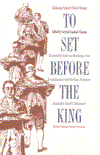To Set before the King
In the 1970s, renowned chef and cookbook collector Louis Szathmáry purchased a notebook written in German and dated 1905, containing more than two hundred recipes for soups, appetizers, main dishes, and a wealth of desserts, ices, and punches. This kitchen notebook, a concrete remnant from the paradoxical world of turn-of-the-century Vienna, belonged to a woman who played an extraordinary role in her society: actress Katharina Schratt, lavishly admired by crowned heads, industrialists, artists, composers—and Franz Joseph I, emperor of Austria and king of Hungary. Schratt was his friend, companion, and confidante for thirty-two years, and these are the foods she served in her home.
To Set Before the King is really three books in one. Gertrud Champe has written an entertaining biography of Schratt and her glittering world. The carefully translated recipes themselves, from Little Croustades à la Talleyrand to Goulash à la Andrássy to Gingerbread à l'Elise, are either comfortable and homey to soothe the highly regimented emperor or elegant and sophisticated to suit the palates of Schratt's more vivacious friends. Finally, working from Schratt's tantalizing aide-mémoire, Chef Louis Szathmáry has created almost a hundred updated Austro-Hungarian recipes that will bring the world of this European metropolis to the tables of today's cooks.
Schratt's notebook is an outstanding representative of its time and place. In the Austrian spirit, the dishes are distinctly central European and late Victorian in character, with a copious use of pork fat, rich and floury desserts, and an interest in intricate garnishes for the good soups that any self-respecting dinner had to include. Almost a hundred years after this notebook was first composed, its pleasures of the table are revealed for all adventurous cooks and diners to enjoy.
Creamed Spinach
2 pounds fresh or 2 12-ounce packages of frozen spinach
2 slices of white bread, crusts removed
1 cup milk
Freshly ground black pepper to taste
1 teaspoon salt
2 tablespoons flour
1 cup chicken broth or water
1 small clove garlic
1 egg
Soak the slices of bread in the milk. Place the washed spinach leaves in a large amount of lightly salted boiling water. Cook for 5 minutes. Drain and cool by rinsing with cold water. Shake dry. If frozen spinach is used, prepare it according to package directions. Chop the spinach very fine, by hand, using a large French knife on a wooden board.
Mash the white bread soaked in the milk. Add the egg. Mash the garlic with the 1 teaspoon salt. Stir the flour and the garlic-salt mixture into the chicken broth or water.
Rinse a large saucepan with cold water. Do not dry. Heat the cooked spinach over medium heat until it starts to bubble and the bubbles break with a sound as they rise. Add the chicken broth or water mixture, stirring vigorously with a wooden spoon or wire whip. Adjust the heat to low and cook the mixture, covered, for 10 minutes, stirring once in a while.
Before serving, stir in the milk and bread mixture. Correct the seasoning, if necessary, with salt and black pepper. Serve.
If you grind the spinach through a meat grinder or a food mill, all of the liquid will come out and only the fibers will remain. When the leaves are chopped by hand, the knife cuts through only the cells directly under the edge of the knife, without pressing the others to remove all the juice.
The milk-soaked bread thickens the spinach and adds a mild filler which heightens the spinach flavor. If you used enough flour to thicken the spinach without the bread, the flavor would be floury.
Mousselines
8 ounces raw chicken breast, skinless and boneless
4 egg whites
1 pint heavy cream or whipping cream
1 quart water, lightly salted
1/8 teaspoon nutmeg
1/2 teaspoon salt
Cut the chicken breasts into 1/2-inch cubes. Grind the meat twice with the finest blade of a meat grinder. Add the nutmeg, salt, half the egg whites, and half the cream. Add half the chicken and puree the mixture until it turns into a frothy, pale substance. Add the remaining egg whites, chicken, and cream. Blend on highest speed until the mixture resembles overwhipped heavy cream. Chill the mixture in the coldest part of your refrigerator for at least 30 minutes.
The mousselines can be colored to add interest to the presentation. To color them orange: Using a fork, mix thoroughly the white of one medium egg and 3 tablespoons of finely grated carrot. Wet a clean kitchen towel and press the mixture through it by folding the four corners of the cloth and squeezing the liquid into a cup or saucer so that the tiny pieces of carrot remain in the cloth but the orange-colored egg white goes through. To color the mousselines red, follow the same procedure using beets; to color them green, follow this procedure, using finely chopped parsley. The mousselines may also be colored by using food coloring.
In a shallow pan, bring to a gentle boil approximately 1 quart of lightly salted water. Dip a tablespoon into the boiling water and use it to take from the mousseline preparation an amount about the size of an unshelled almond. Gently slide it into the water. Repeat until you have eight to ten mousselines.
Increase the heat slightly until the mousselines begin to puff. They will grow to double their original size. Remove from water, drain, and repeat until all batter is used.
It is advisable to cook one mousseline and then taste it for saltiness before cooking more. You can then correct the seasoning by adding more salt if needed. If you want to make the mousselines beforehand, they must be kept submerged in warm water at approximately 160 to 170 degrees until serving time. Do not try to keep them in the stock because they will lose their beautiful snow-white color. For a variation, add fine slivers of tender ham to the mousseline preparation before poaching.




